Inflammatory monocytes are detrimental to the host immune response during acute infection with Cryptococcus neoformans
- PMID: 30897162
- PMCID: PMC6428256
- DOI: 10.1371/journal.ppat.1007627
Inflammatory monocytes are detrimental to the host immune response during acute infection with Cryptococcus neoformans
Abstract
Cryptococcus neoformans is a leading cause of invasive fungal infections among immunocompromised patients. However, the cellular constituents of the innate immune response that promote clearance versus progression of infection upon respiratory acquisition of C. neoformans remain poorly defined. In this study, we found that during acute C. neoformans infection, CCR2+ Ly6Chi inflammatory monocytes (IM) rapidly infiltrate the lungs and mediate fungal trafficking to lung-draining lymph nodes. Interestingly, this influx of IM is detrimental to the host, since ablating IM or impairing their recruitment to the lungs improves murine survival and reduces fungal proliferation and dissemination. Using a novel conditional gene deletion strategy, we determined that MHC class II expression by IM did not mediate their deleterious impact on the host. Furthermore, although ablation of IM reduced the number of lymphocytes, innate lymphoid cells, and eosinophils in the lungs, the effects of IM were not dependent on these cells. We ascertained that IM in the lungs upregulated transcripts associated with alternatively activated (M2) macrophages in response to C. neoformans, consistent with the model that IM assume a cellular phenotype that is permissive for fungal growth. We also determined that conditional knockout of the prototypical M2 marker arginase 1 in IM and deletion of the M2-associated transcription factor STAT6 were not sufficient to reverse the harmful effects of IM. Overall, our findings indicate that C. neoformans can subvert the fungicidal potential of IM to enable the progression of infection through a mechanism that is not dependent on lymphocyte priming, eosinophil recruitment, or downstream M2 macrophage polarization pathways. These results give us new insight into the plasticity of IM function during fungal infections and the level of control that C. neoformans can exert on host immune responses.
Conflict of interest statement
The authors have declared that no competing interests exist.
Figures

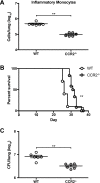
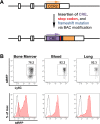

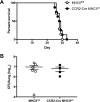
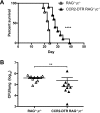
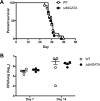
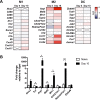

Similar articles
-
CARD9 Is Required for Classical Macrophage Activation and the Induction of Protective Immunity against Pulmonary Cryptococcosis.mBio. 2020 Jan 7;11(1):e03005-19. doi: 10.1128/mBio.03005-19. mBio. 2020. PMID: 31911495 Free PMC article.
-
DAP12 Inhibits Pulmonary Immune Responses to Cryptococcus neoformans.Infect Immun. 2016 May 24;84(6):1879-86. doi: 10.1128/IAI.00222-16. Print 2016 Jun. Infect Immun. 2016. PMID: 27068093 Free PMC article.
-
Group 2 Innate Lymphoid Cells (ILC2) Suppress Beneficial Type 1 Immune Responses During Pulmonary Cryptococcosis.Front Immunol. 2020 Feb 14;11:209. doi: 10.3389/fimmu.2020.00209. eCollection 2020. Front Immunol. 2020. PMID: 32117319 Free PMC article.
-
Innate host defenses against Cryptococcus neoformans.J Microbiol. 2016 Mar;54(3):202-11. doi: 10.1007/s12275-016-5625-7. Epub 2016 Feb 27. J Microbiol. 2016. PMID: 26920880 Review.
-
Detrimental impact of the IL-33/ST2 axis in an animal infection model with Cryptococcus neoformans.Allergol Int. 2023 Oct;72(4):530-536. doi: 10.1016/j.alit.2023.07.002. Epub 2023 Jul 21. Allergol Int. 2023. PMID: 37482531 Review.
Cited by
-
Monocyte-regulated interleukin 12 production drives clearance of Staphylococcus aureus.PLoS Pathog. 2024 Oct 17;20(10):e1012648. doi: 10.1371/journal.ppat.1012648. eCollection 2024 Oct. PLoS Pathog. 2024. PMID: 39418302 Free PMC article.
-
A cardioimmunologist's toolkit: genetic tools to dissect immune cells in cardiac disease.Nat Rev Cardiol. 2022 Jun;19(6):395-413. doi: 10.1038/s41569-022-00701-0. Epub 2022 May 6. Nat Rev Cardiol. 2022. PMID: 35523863 Review.
-
Innate Pulmonary Phagocytes and Their Interactions with Pathogenic Cryptococcus Species.J Fungi (Basel). 2023 May 27;9(6):617. doi: 10.3390/jof9060617. J Fungi (Basel). 2023. PMID: 37367553 Free PMC article. Review.
-
iPSC-derived exosomes as amphotericin B carriers: a promising approach to combat cryptococcal meningitis.Front Microbiol. 2025 Feb 10;16:1531425. doi: 10.3389/fmicb.2025.1531425. eCollection 2025. Front Microbiol. 2025. PMID: 39996080 Free PMC article.
-
Macrophage Fate Mapping.Curr Protoc. 2022 Jun;2(6):e456. doi: 10.1002/cpz1.456. Curr Protoc. 2022. PMID: 35687806 Free PMC article.
References
-
- Heitman J, Kozel T. R., Kwon-Chung K. J., Perfect J. R. and Casadevall A. Cryptococcus: From Human Pathogen to Model Yeast 1 ed: ASM Press; 2010.
Publication types
MeSH terms
Substances
Grants and funding
LinkOut - more resources
Full Text Sources
Other Literature Sources
Medical
Molecular Biology Databases
Research Materials
Miscellaneous

